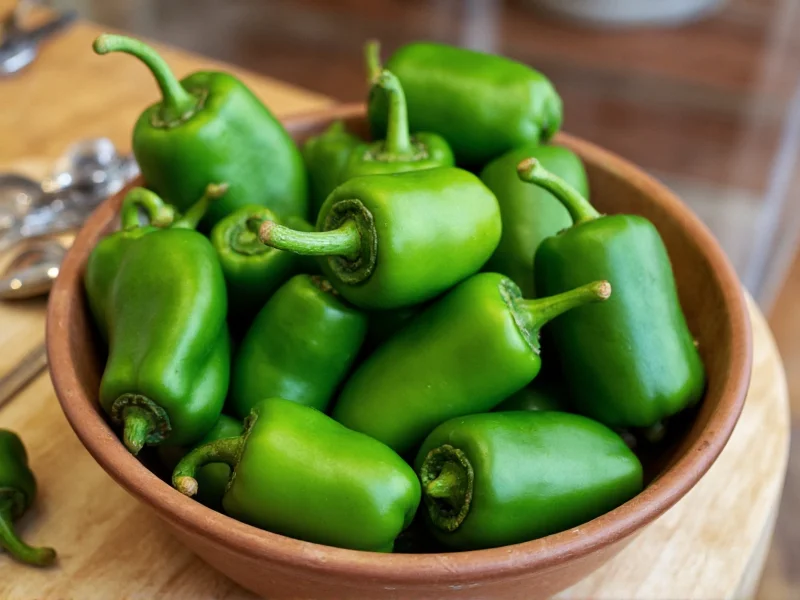When exploring the world of chili peppers, understanding poblano pepper heat level is essential for home cooks and culinary enthusiasts. These large, dark green peppers—often called chiles poblanos in Mexican cuisine—deliver a subtle warmth rather than intense heat, placing them firmly in the mild category of the Scoville scale.
Understanding Poblano Pepper Heat Measurement
The Scoville scale quantifies spiciness by measuring capsaicin concentration. Poblano peppers register between 1,000-2,000 Scoville Heat Units, which explains why they're considered mild. To put this in perspective, a bell pepper measures 0 SHU (no heat), while a jalapeño ranges from 2,500-8,000 SHU—making poblanos noticeably milder than their more famous cousin.
Several factors influence how spicy poblano peppers taste in practice:
- Ripeness: As poblanos mature and turn from dark green to red (sometimes called chiles anchos when dried), their heat can increase slightly
- Growing conditions: Soil composition, climate, and water stress affect capsaicin production
- Individual variation: Even within the same plant, heat levels can vary between peppers
- Seed and membrane content: The white ribs and seeds contain most capsaicin—removing them reduces heat
Comparing Poblano Pepper Heat to Other Varieties
Understanding where poblanos fall in the pepper heat spectrum helps determine their best culinary applications. The following comparison shows how poblano pepper spiciness stacks up against other common varieties:
| Pepper Variety | Scoville Heat Units (SHU) | Heat Level | Compared to Poblano |
|---|---|---|---|
| Bell Pepper | 0 | None | Not spicy at all |
| Poblano Pepper | 1,000-2,000 | Mild | Baseline for comparison |
| Pepperoncini | 100-500 | Very Mild | Slightly milder than poblano |
| Jalapeño | 2,500-8,000 | Moderate | 2-4 times hotter than poblano |
| Serrano | 10,000-23,000 | Hot | 5-10 times hotter than poblano |
| Habanero | 100,000-350,000 | Very Hot | 50-175 times hotter than poblano |
Culinary Applications of Mildly Spicy Poblanos
The gentle heat of poblano peppers makes them exceptionally versatile in cooking. Unlike intensely spicy varieties that dominate a dish, poblanos contribute a subtle warmth that enhances rather than overwhelms other flavors. Chefs appreciate their earthy, slightly fruity flavor profile that complements both traditional Mexican dishes and fusion cuisine.
Popular preparations include:
- Chiles Rellenos: Stuffed poblano peppers are a classic Mexican dish where the mild heat allows fillings like cheese to shine
- Rajas con Crema: Sliced roasted poblanos in cream sauce—perfect for those who enjoy are poblano peppers hot enough for authentic flavor without excessive spice
- Mole sauces: Dried poblanos (anchos) form the base of many complex mole varieties
- Guacamole and salsas: Adds depth without making the dish too spicy
- Stews and soups: Provides background warmth that develops during cooking
Factors That Increase Poblano Pepper Heat
While generally mild, certain conditions can make poblano peppers spicier than average. Gardeners and cooks should understand these variables when working with fresh poblanos:
Environmental stressors significantly impact heat levels. When pepper plants experience water stress, temperature extremes, or nutrient deficiencies, they often produce more capsaicin as a defense mechanism. This explains why two poblanos from different sources might taste noticeably different in spiciness.
Harvest timing also matters. Poblanos harvested later in the season when fully mature tend to be slightly hotter than younger peppers. The same plant can produce peppers with varying heat levels throughout the growing season.
For those sensitive to spice, preparation techniques can reduce heat:
- Remove all white ribs and seeds (where most capsaicin concentrates)
- Soak sliced peppers in salt water for 15-20 minutes before cooking
- Cook with dairy products which help neutralize capsaicin
- Pair with sweet ingredients like corn or roasted squash
Common Misconceptions About Poblano Heat
Several myths persist about poblano peppers that can confuse cooks. Understanding these helps set proper expectations when using them in recipes.
Myth: Poblanos are the same as pasilla peppers. While dried poblanos are sometimes called anchos, pasilla peppers are actually dried chilacas—a different variety entirely. Pasillas typically run hotter than fresh poblanos.
Myth: All poblanos taste the same. Significant variation exists between individual peppers, even from the same plant. This natural variability explains why someone might occasionally encounter a noticeably spicier poblano than expected.
Myth: Poblano heat increases dramatically when cooked. Unlike some compounds that intensify with heat, capsaicin remains relatively stable during cooking. Roasting poblanos actually mellows their flavor while concentrating natural sugars.
Using Poblanos for Different Heat Tolerance Levels
One reason poblano peppers remain popular across diverse palates is their adaptability. Whether you're cooking for children, spice-sensitive individuals, or heat enthusiasts, poblanos can be modified to suit various tolerance levels.
For mild preparations (ideal for children or spice-averse eaters):
- Remove all seeds and white membranes
- Soak in milk or buttermilk for 30 minutes before use
- Combine with sweet ingredients like roasted corn or plantains
For moderate heat (standard preparation for most recipes):
- Remove seeds but leave some white ribs
- Roast to enhance natural sweetness while maintaining mild warmth
- Combine with complementary spices like cumin and oregano
For increased heat (when you want more spice from poblanos):
- Leave some seeds and ribs intact
- Add a small amount of hotter pepper (like a pinch of cayenne) to enhance rather than replace
- Use in dishes with acidic components like tomatoes which can amplify perceived heat











 浙公网安备
33010002000092号
浙公网安备
33010002000092号 浙B2-20120091-4
浙B2-20120091-4